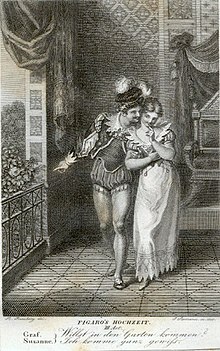| Le nozze di Figaro The Marriage of Figaro | |
|---|---|
| Opera by W. A. Mozart | |
 Early 19th-century engraving depicting Count Almaviva and Susanna in act 3 | |
| Native title | Le nozze di Figaro |
| Librettist | Lorenzo Da Ponte |
| Language | Italian |
| Based on | La folle journée, ou le Mariage de Figaro by Pierre Beaumarchais |
| Premiere | 1 May 1786 Burgtheater, Vienna |
The Marriage of Figaro (Italian: Le nozze di Figaro, pronounced [le ˈnɔttse di ˈfiːɡaro] ), K. 492, is a commedia per musica (opera buffa) in four acts composed in 1786 by Wolfgang Amadeus Mozart, with an Italian libretto written by Lorenzo Da Ponte. It premiered at the Burgtheater in Vienna on 1 May 1786. The opera's libretto is based on the 1784 stage comedy by Pierre Beaumarchais, La folle journée, ou le Mariage de Figaro ("The Mad Day, or The Marriage of Figaro"). It tells how the servants Figaro and Susanna succeed in getting married, foiling the efforts of their philandering employer Count Almaviva to seduce Susanna and teaching him a lesson in fidelity.
Considered one of the greatest operas ever written,[1] it is a cornerstone of the repertoire and appears consistently among the top ten in the Operabase list of most frequently performed operas.[2] In 2017, BBC News Magazine asked 172 opera singers to vote for the best operas ever written. The Marriage of Figaro came in first out of the 20 operas featured, with the magazine describing the work as being "one of the supreme masterpieces of operatic comedy, whose rich sense of humanity shines out of Mozart's miraculous score".[1]
- ^ a b "The 20 Greatest Operas of All Time". Classical Music.
- ^ "Statistics for the five seasons 2009/10 to 2013/14". Operabase. Archived from the original on 4 March 2016. Retrieved 11 January 2015.